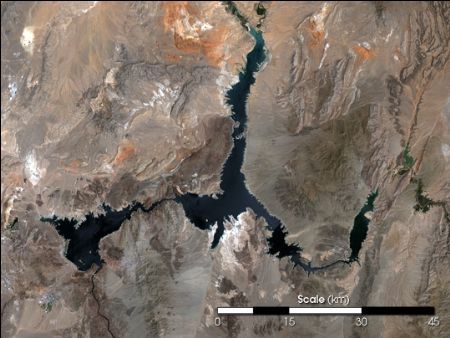by Larry
June, 2009Lake Mead Highs and LowsThe project to create Lake Mead, blocking the Colorado River with Hoover Dam, was begun in 1931, completed in 1936. As envisioned, it would abundantly yield needed water and power in its environs for the foreseeable future. At present, it provides hydroelectric energy for CA, NV, and AR and is also a huge recreation area. In addition, Lake Mead is the main reservoir for the water requirements of Las Vegas, about 30 miles away. Moreover, it irrigates in excess of a million acres in the U.S. and Mexico. Lake Mead water may be found in Los Angeles swimming pools, on Tucson golf courses, and on Imperial and Mexicali valley farms. 88% of the drinking water used in southern NV comes from this body.
But there is a problem. Officially, one is told that it was always intended that Lake Mead would rise and fall and that its currently low level is no cause for alarm. Weather variations were factored into the design and strategic planning for the reservoir. There will, of course, be times of flood as well as ones of drought. When there is plentiful inflow from its enormous watershed, Lake Mead fills up to capacity. At other times, there may be periods such as we see now when a white "bathtub ring" of deposits around the declining lake reveals how much higher it was in the past. Everything is normal, we are assured. Well, yes, except that much of the water for Lake Mead was to come from snowmelt off the nearby mountains, and there has not been much snow lately. Students of the climate tell us there may be a lot less in future. What is just to be expected for Lake Mead, according to government spokesmen, may not be enough in the short-term for Las Vegas and other primary users of its water. It is now anticipated that if the water level, already at its lowest in over 40 years, falls just a little more, one of the two intakes for much of the water from the reservoir will have to be shut down, threatening supplies for farms, commercial interests, and residences. Projects are in the works to bring in extra water via underground sources in northern NV. These are to be initiated if Lake Mead's level drops by another 20-30 feet. Many are hopeful it will not come to that, partly because using underground water from elsewhere in the state may lower the water table and natural supplies for farmers and wildlife there, and partly as well, of course, because ongoing growth of the metropolitan areas depends on a much more plentiful water supply. Yet the drought has already lasted about a decade, and there is little expectation of record snowfalls in the Rockies anytime soon. Locales dependent on Lake Mead may be among the first in the country to face a severe water bottleneck, reducing regular water use and rates of new development. Completion of costly projects to provide groundwater for Las Vegas and other strapped areas previously supplied by Lake Mead, is not anticipated for a few years. NV officials have even been considering Pacific seawater desalination to get enough potable water to the southern part of their state, but that too has downsides and would take several years to initiate. Proposals to release water from smaller reservoirs upstream from Lake Mead, and so offset the drop in Las Vegas' water supply, would have drawbacks as well and could not remedy the city's difficulties for at least another year or two. Unless there is a major break in the weather, severe shortages and/or higher water bills could affect both urban and agricultural water users starting as early as this summer. The short- to medium-term regional water deficits that Lake Mead's declining levels herald will certainly be solved. Communities and cities dependent on the reservoir will surely not be allowed to become ghost towns. Even if at great initial government and investor cost, by one method or another private enterprise will deliver the means to overcome any looming crises. Long-term, though, they point to a global challenge: how shall we as a species best use the planet's limited resources in a sustainable way? |
